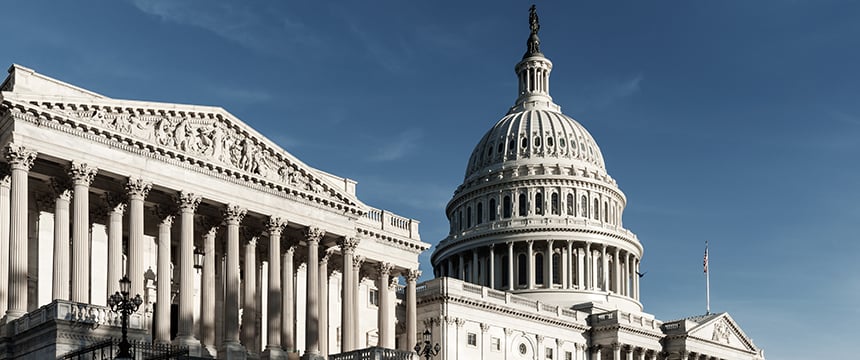
On Friday morning, November 19th, the House of Representatives passed H.R. 5376, the Build Back Better Act, on a party-line vote of 220 – 213, Rep. Jared Golden of Maine was the only Democrat to vote against the bill. The bill now heads to the Senate where it is likely to undergo significant changes as Senate Democrats attempt to pass the bill through the reconciliation process, in which all 50 members of the Democratic caucus must vote for the bill and it must survive a budgetary challenge known as “The Byrd Rule.”
This bill represents a key point of President Joe Biden’s economic agenda, with an emphasis on funding means to combat climate change, expand healthcare, and various tax incentives for business and consumers alike. You can read the House passed version of the bill here.
Notable provisions within the Build Back Better Act include:
-
- $555 billion to combat climate change.
- The largest amount of money in the bill is allocated towards fighting climate change. The majority of the spending, $320 billion, comes in the form of tax credits for manufacturers and consumers alike. Major tax credits include:
- Production tax credit for energy facilities that produce electricity from a renewable source.
- Investment tax credit for clean energy projects that serve low-income communities.
- Clean electricity production credit and investment credit based on carbon emissions.
- New zero-emission nuclear power credit for electric production facilities.
- New credit for production of clean hydrogen.
- Credit for domestic production of clean fuels.
- The largest amount of money in the bill is allocated towards fighting climate change. The majority of the spending, $320 billion, comes in the form of tax credits for manufacturers and consumers alike. Major tax credits include:
- $555 billion to combat climate change.
-
- Expanded tax credits for electric vehicles.
- The tax credit for the production of electric vehicles has been increased to $12,500 from $7,500.
- This applies to qualified vehicles made in the United States and by union-organized manufacturers.
- A new tax credit of $4,000 has been created for the purchase of used electric vehicles.
- The tax credit for the production of electric vehicles has been increased to $12,500 from $7,500.
- Fines to reduce emissions of methane gas.
- New plan would provide the EPA with $775 million in grants, rebates, contracts, and loans to reduce methane gas emissions.
- Establishes fines on waste emission of methane gas. These fines start at $900 per ton of overage in 2023 and $1,500 per ton in 2025.
- Investment into expansion of the Affordable Care Act (ACA) and Medicaid.
- Expansion of subsidies for insurance plans sold through the ACA marketplace. These subsidies were originally temporarily extended through 2022 as a part of the American Rescue Plan. Under the Build Back Better Act they are extended until 2025.
- Through 2025, expansion of tax credits for those that live under 100% under the federal poverty line and live in states that did not take part in the Medicaid expansion program.
- $150 billion towards elderly and disabled long-term at-home care services.
- $10 billion to establish an annual health insurance affordability fund to the states for a reinsurance program or to reduce out-of-pocket costs.
- New rules for prescription drug pricing.
- Provides the Department of Health and Human Services (HHS) with $300 million to establish a Drug Negotiation Program to reduce costs of prescription drugs. Each year beginning in 2025, the HHS would identify 100 brand-name drugs that lack competition for negotiation of fair prices.
- Ensures coverage of at least one of each type and dosage of insulin. Imposes a cap of $35 for out-of-pocket co-pays.
- Requires drug manufacturers to pay a rebate should their prices increase faster than the rate of inflation. Starting in 2023, this would apply to single-source drugs, biologicals covered under Medicare Part B, and nearly all covered drugs under Part D.
- New taxes on corporations and high-income individuals.
- Establishes a 15% minimum corporate tax and a 15% global minimum tax rate for corporation’s foreign profits.
- Imposes a surtax minimum of 5% on individual incomes greater than $10 million.
- An additional 3% would be added on for incomes greater than $25 million.
- A new limit of 80% of adjusted financial statement income can be used to reduce income for taxes.
- $10 million cap on individual retirement accounts.
- Expansion of the State and Local Tax (SALT) deduction from $10,000 to $80,000 until 2030. It would return to $10,000 in 2031.
- Expanded tax credits for electric vehicles.
-
- Extension and expansion of existing tax credits.
- $200 billion to extend and offer changes to the child tax credit through 2022. This tax credit was created in March of 2020 and provides a monthly payment of $300 per child under the age of six and $250 per child ages six to 17. The income cap for this tax credit has been set at $150,000 a year.
- Extension of the earned income tax credit for childless workers through 2022. Under this provision, the credit is increased to $3,000 for per child ages 6-17 and $3,600 per child under the age of six.
- Creation of paid leave and universal preschool programs.
- Starting in 2024, $200 billion is allocated for workers to be provided with up to four weeks of paid leave should their employer not provide it.
- Employees will receive up to 90% of their income, this will scale down for high-income earners.
- Workers are eligible for this program regardless of size of employer and whether or not the worker is self-employed.
- $380 billion in new spending is spread out over six years for the states to create universal preschool programs.
- Programs are spread out among public schools, community-based programs, and Head Start programs.
- Low income parents would not be required to pay. High-income parents would have to pay up to 7% of their income for such programs.
- Starting in 2024, $200 billion is allocated for workers to be provided with up to four weeks of paid leave should their employer not provide it.
- Funding for affordable housing programs.
- $170 billion is allocated towards the creation of more affordable housing opportunities for low-income individuals.
- $65 billion will go towards repairing and rebuilding of public housing.
- $25 billion will go towards federal housing vouchers.
- $15 billion will go towards the housing trust program.
- $170 billion is allocated towards the creation of more affordable housing opportunities for low-income individuals.
- Extension and expansion of existing tax credits.
- Build Back Better’s impact on the national deficit.
- A vast majority of the spending would be offset through changes in the tax code and new tax enforcement tactics by the Internal Revenue Service. The nonpartisan Congressional Budget Office has estimated that the Build Back Better Act would increase the national deficit by $240 billion.
The Build Back Better Act now heads to the Senate where it faces opposition from Democrats on both ends of the political spectrum. The bill is likely to undergo several more changes, as provisions such as increasing the cap on SALT, climate change, and paid family leave have been controversial among both the party’s moderate and progressive wings. Senate Majority Leader Chuck Schumer (D-NY) has promised a vote on the package by the end of 2021.
